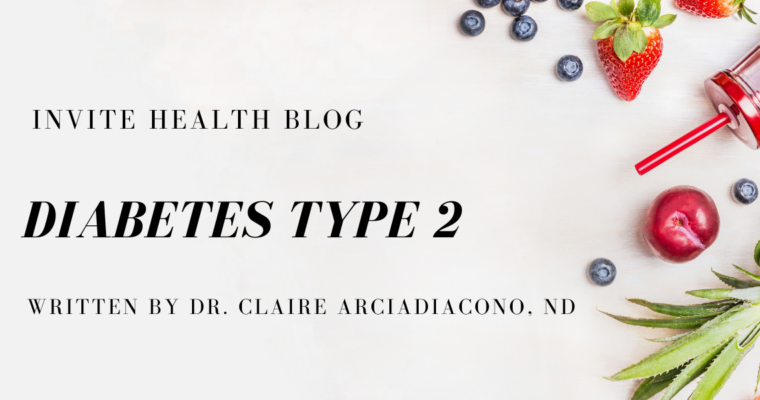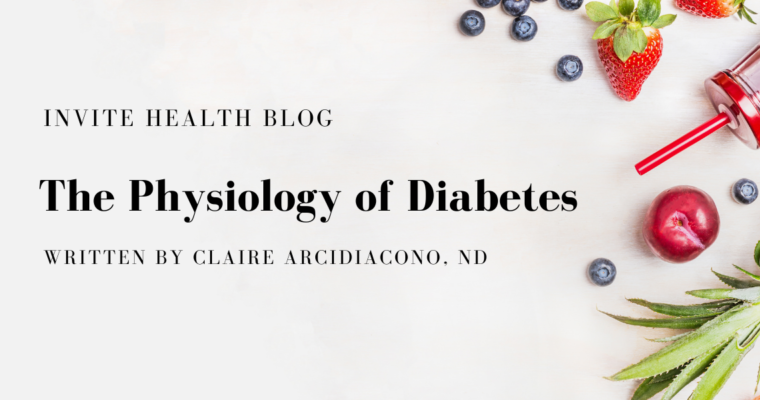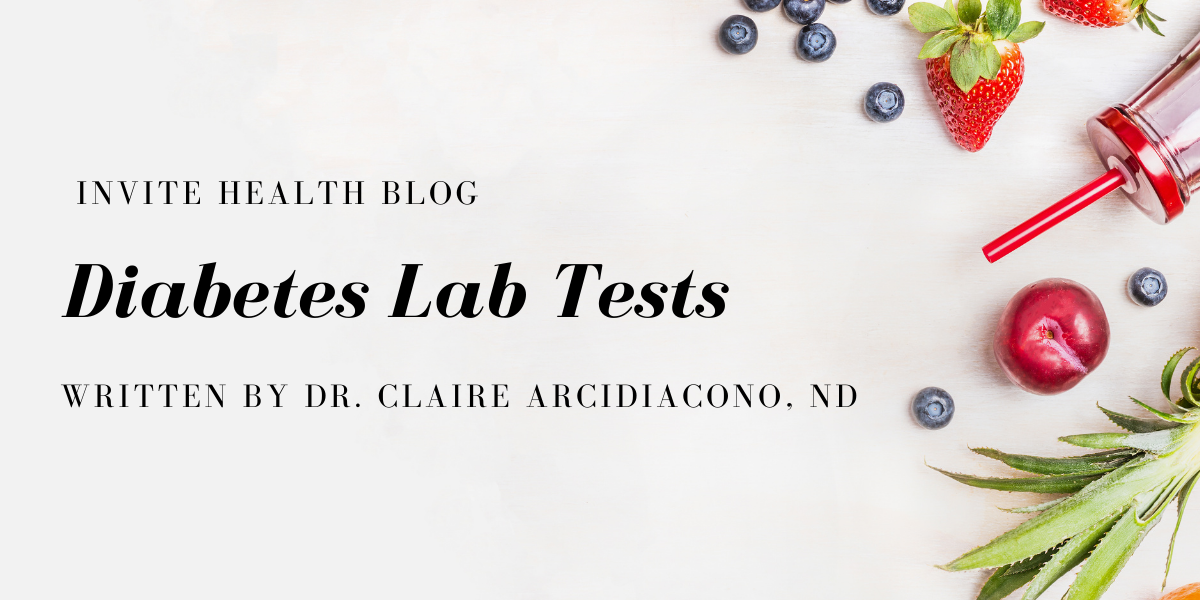Diabetes type 1
Written by: Dr. Claire Arcidiacono, ND
For further questions or concerns email me at carcidiacono@invitehealth.com†

Diabetes type 1 is a type of diabetes that is commonly found in children. In fact it used to be called juvenile diabetes. But what is diabetes type one? To start with, it is an autoimmune disease of the cells of the pancreas that produce insulin. While there are many hypothesis as to why the immune system starts to attack the pancreas as of now no single reason has been confirmed as the cause. Now the destruction of the cells in the pancreas that produce insulin means that no insulin is produced. While the blood sugar going up would normally signal the body to produce insulin due to the destruction of the insulin producing cells no insulin is made. This is what makes diabetes type one so unique. In general in other cases of high blood sugar there is actually adequate insulin but the body loses its sensitivities to it. Thus treating diabetes type one is more about replacing the missing insulin and protecting the body from damage caused by high blood sugar. (1) †
SYMPTOMS OF DIABETES
What are the symptoms of diabetes? Type one diabetes is usually diagnosed in childhood, in my clinical experience it is usually diagnosed quite young. However, I have had clinical experience where diagnosis was delayed or children were actually misdiagnosed at first and later diagnosed as diabetic. Due to the possible complications of diabetes this is a huge concern. If you suspect your child has diabetes please see a doctor as soon as possible? Usually the first sign of diabetes type one is high blood sugar. This is usually accompanied by increased urination as well as increased thirst. Other symptoms include increased appetite with weight loss, blurred vision, bed wetting, and irritability and performance issues at school. Recurrent skin infections can also indicate high blood sugar. (2) If diagnosis is delayed there an also be persistent fatigue, dry or flushed skin, abdominal pain as well as nausea and vomiting. Additionally the child may act confused and have trouble breathing. Interestingly there can even be a fruity smell to the breath. (3) †
RISK FACTORS
As I stated at the beginning of this blog, in type one diabetes the insulin producing cells are destroyed by the immune system. For unknown reasons the body is triggered to make antibodies that then destroy the insulin producing cells. There are certain risk factors that are being studied at this time. These include genetic susceptibility, diabetic triggers and or exposure to an antigen. (4) It also appears that the risk of diabetes type one is higher in children of mothers what are obese or older than 35. It also appears as though a cesarean birth is also a risk factor. There has also been found to be an association with cow’s milk intake as well as high sugar intake. Some studies have found an association of diabetes type 1 with gluten intake. (5) Certain medications are also associated with an increased risk of type 1 diabetes. (6) †
DIAGNOSIS
Diagnosis is done by testing the blood sugar as well as the A1C. For more information please see my previous blogs on these blood tests.
Complications from diabetes are very severe. According to the National institute of diabetes and digestive and kidney diseases about 130,000 people in the United States with diabetes have amputations each year. (7) Other complications include keto acidosis, hyperosmolar coma, poor healing, heart disease (and all the complications that fall under this category), hypoglycemia (once again all of the complications associated with this) and damage to eyes. There can also be confusion, memory loss, and even seizures. And of course coma. Diabetes can also damage the nerves as well as the blood vessels leading to poor circulation. (8) †
Diabetes type one is treated with insulin. There is no way around this. Diabetics type one DO NOT PRODUCE INSULIN therefore they must take it. Yes there is such a thing as a “brittle diabetic” however that is a unique concern that does not affect the majority of type 1 diabetics. I want to emphasize that the supplements that are fantastic for other types of diabetics do not replace insulin. A type one diabetic cannot just take a supplement to increase sensitivities to insulin because as I’ve said they don’t make it. Insulin can be given via subcutaneous injection with a syringe or an insulin pump. Blood sugar can also be managed with diet and exercise. Because the complications from diabetes type 1 are so severe we want to help keep the body healthy and this is where supplements can be fantastic!
DIABETES LAB TESTS>>READ NOW!
NUTRITIONAL SUPPORT
ALA has been found in studies to help with damaged nerves. It has even been found that it can help in cases of nerve apoxia! This is important because the high blood sugar in diabetes can damage nerves. (9) Please see Invite’s Alcar with ALA or our ALA formula.
Benfotiamine (fat soluble B1) has been found in studies to help with the symptoms of neuropathy (10) Please see Invite’s Nerve Hx!
Methyl-B is a combination of B vitamins that are methylated. Studies show that b vitamins can help with nerve damage and even peripheral neuropathy (11)
Beets have been found to help with circulation which is a concern for long term diabetics! In long term diabetes the inflammation can affect the circulation.
In addition to helping with overall circulation studies show that beets can help to lower the inflammation. (12) Please see Invite’s Beets Hx
Chromium, Zinc and Magnesium have been correlated with better blood sugar control. Studies show that those with low levels of these nutrients have less stable or even poorly controlled blood sugar. (13) Please see Invite health for all of our options containing these fantastic nutrients!
Multivitamins are important to help prevent any deficiencies and for overall health. Additionally studies show that in the long term a good multivitamin can help with energy. (14) Please see Invite’s extensive line of multi vitamins!
THE NUTRITIONAL ASPECT ON CONTROLLING BLOOD SUGAR HEALTH
Next week we will navigate the confusing world of PREDIABETES!
SOURCES
“Diabetes Fact sheet N°312”. WHO. November 2016. Archived from the original on 26 August 2013. Retrieved 29 May 2017.
Wolsdorf & Garvey 2016, “Type 1 Diabetes”.
“DKA (Ketoacidosis) & Ketones”. American Diabetes Association. Retrieved 28 July 2021.
Chiang JL, Kirkman MS, Laffel LM, Peters AL (July 2014). “Type 1 diabetes through the life span: a position statement of the American Diabetes Association”. Diabetes Care. 37 (7): 2034–2054. doi:10.2337/dc14-1140. PMC 5865481. PMID 24935775.
Norris, Johnson & Stene 2020, “Environmental factors”.
Repaske 2016, “Additional medications that decrease insulin release”.
https://www.healthline.com/health/diabetes/diabetes-amputation
Chiang JL, Kirkman MS, Laffel LM, Peters AL (July 2014). “Type 1 diabetes through the life span: a position statement of the American Diabetes Association”. Diabetes Care. 37 (7): 2034–2054. doi:10.2337/dc14-1140. PMC 5865481. PMID 24935775.
https://www.ncbi.nlm.nih.gov/pmc/articles/PMC2836194/
https://www.thieme-connect.com/products/ejournals/abstract/10.1055/s-0029-1211460
https://www.ncbi.nlm.nih.gov/pmc/articles/PMC8294980/
https://pubmed.ncbi.nlm.nih.gov/31343948/
https://pubmed.ncbi.nlm.nih.gov/26406393/
https://www.ncbi.nlm.nih.gov/pmc/articles/PMC4750202/











